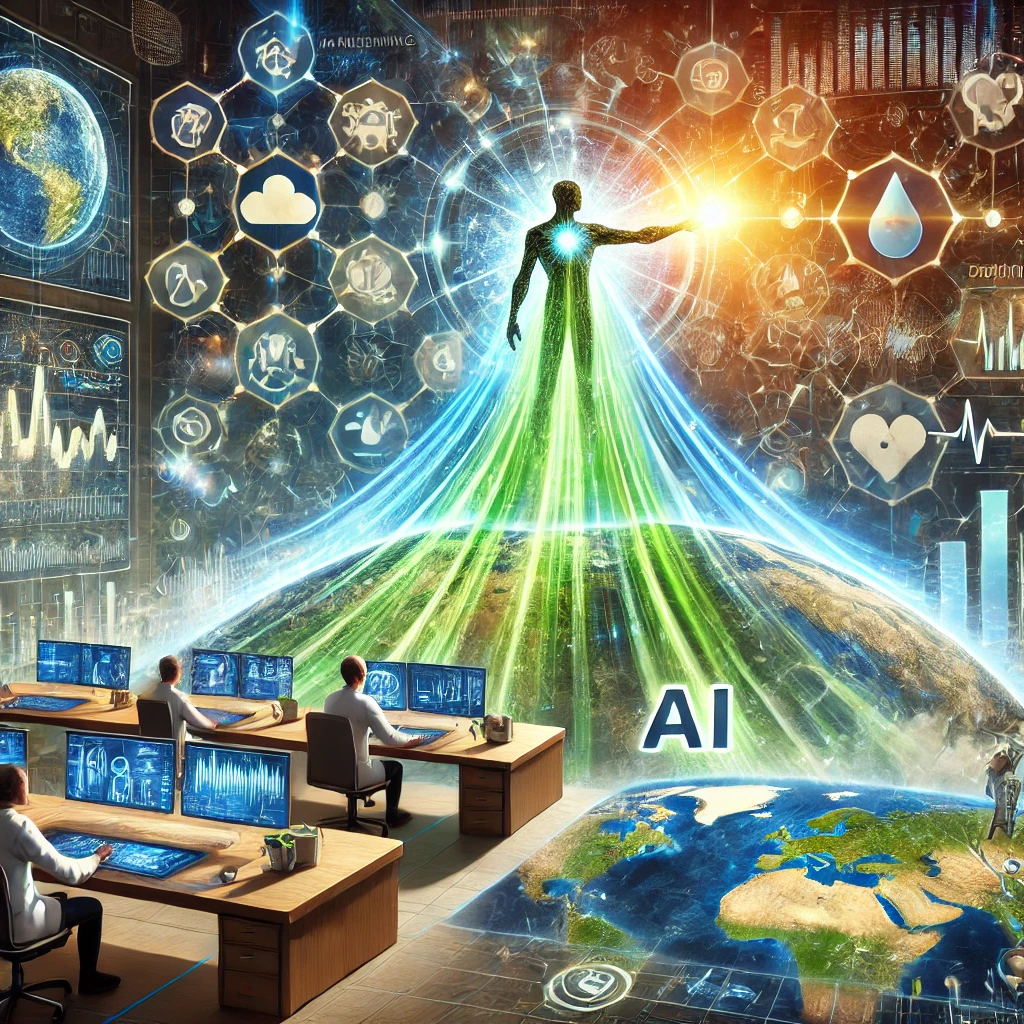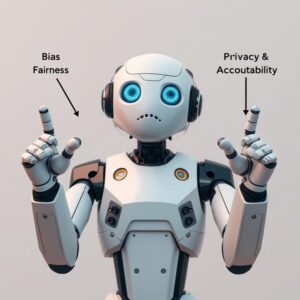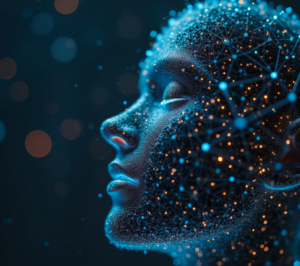
Discover how AI can be used for social good. Explore its potential to solve pressing global challenges such as climate change, poverty, healthcare, and education.
Artificial Intelligence (AI) is often seen as a technology that transforms industries, boosts productivity, and creates new economic opportunities. However, AI’s true potential goes far beyond these commercial applications. The concept of “AI for Good” refers to the utilization of artificial intelligence to address pressing global challenges—such as health disparities, poverty, climate change, and educational inequities—by using its capabilities to enhance lives and promote social equity.
In recent years, a growing number of organizations, governments, and non-profits have recognized the power of AI to tackle these challenges and improve the human condition. From healthcare innovation to environmental protection, AI for Good encompasses a wide range of applications aimed at solving some of the world’s most urgent problems. But with this potential comes the responsibility to ensure AI is used ethically, transparently, and equitably.
In this article, we’ll explore some of the most impactful ways AI is being harnessed for social good, and the ethical considerations we must address to ensure it benefits all of humanity.
The Role of AI in Addressing Global Challenges
AI’s influence on society is vast, spanning multiple sectors and fields. Here are some key areas where AI is already making a tangible difference:
1. AI in Healthcare: Saving Lives and Improving Access
Healthcare is one of the most promising areas where AI can create a significant impact. AI has the potential to save lives by enabling early diagnosis, improving treatment outcomes, and increasing access to care. Here are several ways AI is being applied in the healthcare sector:
-
Diagnostics and Early Detection: AI systems are becoming highly proficient at analyzing medical images such as X-rays, MRIs, and CT scans. By using deep learning techniques, these systems can detect anomalies such as tumors or fractures, sometimes with greater accuracy than human doctors. For example, AI has shown promise in detecting early-stage cancers, particularly breast and lung cancer, enabling earlier, more effective interventions.
-
Telemedicine and Remote Healthcare: AI-powered platforms are transforming telemedicine by providing virtual consultations, reducing the need for in-person visits, and expanding access to healthcare in underserved or rural regions. Virtual health assistants and AI-driven chatbots can diagnose common ailments, schedule appointments, and offer health advice, allowing doctors to focus on more complex cases. This is especially important in places with limited access to healthcare professionals.
-
Personalized Medicine: AI can analyze a patient’s genetic information, lifestyle, and medical history to design personalized treatment plans. This could lead to more effective treatments with fewer side effects, particularly for complex conditions like cancer, heart disease, and chronic illnesses.
-
Predictive Analytics: AI can also be used to predict disease outbreaks, allowing public health authorities to prepare in advance. For instance, AI is being used to monitor and predict the spread of infectious diseases like COVID-19, helping governments take action to control outbreaks before they spiral out of control.
2. AI for Education: Personalizing Learning and Bridging Gaps
Education is a fundamental human right, yet many people around the world still lack access to quality education. AI is helping bridge the gap in several ways, ensuring that learning is more personalized, efficient, and accessible:
-
Personalized Learning: AI is enabling personalized learning experiences by tailoring lessons to the needs, pace, and interests of individual students. Platforms like Khan Academy and Duolingo use AI to assess students’ strengths and weaknesses, adjusting the curriculum and providing real-time feedback. This helps students learn at their own pace, improving their chances of success.
-
Online Learning Platforms: AI is driving the rise of e-learning platforms, enabling remote learning opportunities for students across the globe. These platforms use AI to adapt lessons based on user performance, suggesting areas for improvement and delivering content in ways that engage students more effectively. This is particularly beneficial in areas where access to in-person education is limited.
-
Scaling Education in Low-Resource Areas: In developing regions where schools and teachers are in short supply, AI-powered educational tools can provide scalable, quality education to students. By using interactive learning apps and tools, students in remote or impoverished areas can access the same educational resources as their counterparts in more developed regions.
-
Teacher Support: AI is also supporting educators by automating time-consuming administrative tasks like grading, lesson planning, and progress tracking. This allows teachers to spend more time focusing on direct interaction with students and addressing individual learning needs.
3. AI and Climate Change: Protecting the Planet
Climate change is one of the most pressing global challenges, and AI can play a key role in both mitigating its effects and helping to adapt to its consequences:
-
Energy Optimization: AI can optimize energy usage by predicting demand and supply fluctuations. Smart grids powered by AI are designed to balance electricity supply from renewable sources like solar and wind, which are inherently variable. AI can analyze data from these renewable sources to optimize the distribution of energy and reduce reliance on fossil fuels, ultimately leading to a decrease in greenhouse gas emissions.
-
Climate Modeling and Predictions: Climate change modeling requires vast amounts of data from satellite images, weather stations, and sensors. AI algorithms can help process and analyze this data to create more accurate models of climate patterns, making it easier to predict extreme weather events such as hurricanes, floods, or droughts. These predictions can help governments and communities take proactive steps to prepare for climate disasters.
-
Sustainable Agriculture: AI is also being applied to agriculture to help reduce the environmental impact of food production. AI-powered systems can optimize water usage, monitor crop health, and predict harvest times, allowing farmers to maximize crop yields while minimizing waste and resource consumption. In the long term, this can help ensure global food security while reducing the carbon footprint of agriculture.
-
Wildlife Conservation: AI is being used in the field of wildlife conservation to monitor endangered species and protect biodiversity. For instance, AI algorithms are used to process camera trap images, automatically identifying species and monitoring populations. AI-powered drones can also patrol wildlife reserves to detect illegal poaching or logging activities.
4. AI for Social Justice: Reducing Inequality
AI also has the potential to reduce social inequality and promote fairness across various sectors:
-
Reducing Bias in Hiring: AI can help eliminate human biases in hiring processes by analyzing job applications and resumes without being influenced by race, gender, age, or socioeconomic background. With proper design and oversight, AI systems can help create more inclusive and diverse workplaces, allowing candidates to be evaluated based on skills and qualifications rather than personal characteristics.
-
Financial Inclusion: In many parts of the world, access to banking and financial services is limited. AI can help by providing digital financial services to individuals who do not have access to traditional banking systems. For example, AI-powered credit scoring models can assess creditworthiness based on alternative data sources, such as mobile phone usage or social behavior, enabling underserved populations to access credit and loans.
-
Addressing Inequalities in Healthcare: AI can identify health disparities across different populations, helping to pinpoint why certain groups may be disproportionately affected by diseases. By analyzing social, economic, and healthcare data, AI can help identify the root causes of these disparities and propose targeted interventions to reduce health inequities.
-
AI for Crime Prevention and Justice: AI is being used to analyze patterns in crime data to predict and prevent criminal activity, particularly in urban areas. It can help law enforcement agencies allocate resources more effectively and identify areas where intervention is needed. However, this also raises concerns about surveillance and privacy, highlighting the need for ethical frameworks around the use of AI in law enforcement.
The Ethical Considerations of AI for Good
While AI has immense potential to bring about social good, it also raises important ethical concerns that must be addressed to ensure that it is used responsibly:
-
Bias and Fairness: AI systems are only as unbiased as the data they are trained on. If the training data is biased, the AI system will likely perpetuate those biases. This is particularly concerning in areas like hiring, law enforcement, and healthcare, where biased AI decisions can lead to unfair outcomes. To mitigate this risk, it’s essential to use diverse, representative datasets and implement ongoing audits to ensure AI systems remain fair.
-
Privacy and Security: AI technologies often require large amounts of personal data to function effectively. This raises concerns about data privacy and security. It’s important to implement privacy-conscious design principles and ensure that AI systems comply with privacy regulations such as the GDPR. Strong encryption and secure data storage practices are essential to prevent unauthorized access to sensitive data.
-
Transparency and Accountability: AI systems are often referred to as “black boxes” because it can be difficult to understand how they make decisions. This lack of transparency can lead to a loss of trust, particularly when AI is used in high-stakes areas like healthcare or criminal justice. It’s crucial to develop Explainable AI (XAI) systems that provide clear, understandable explanations of their decision-making processes.
-
Environmental Impact: While AI can be used to combat climate change, it’s also important to consider the environmental impact of AI development itself. Training large-scale AI models requires significant computational resources and energy, which can contribute to environmental degradation. To mitigate this, AI developers must focus on creating energy-efficient algorithms and sustainable AI technologies.
The Future of AI for Good: Opportunities and Challenges
The future of AI for good is incredibly promising, but it also presents several challenges that will need to be addressed in the coming years:
1. Opportunities
- Global Collaboration: AI for good initiatives require collaboration between governments, NGOs, private companies, and academic institutions. By working together, stakeholders can share knowledge, resources, and data, maximizing the impact of AI on global challenges.
- AI as a Catalyst for Innovation: AI has the potential to accelerate innovation in fields like renewable energy, healthcare, and education, creating new solutions to long-standing problems. The development of AI tools that prioritize social good will be key to this progress.
2. Challenges
-
Equitable Access to Technology: One of the biggest challenges is ensuring equitable access to AI technology. Communities in developing countries may not have the infrastructure or resources to fully take advantage of AI, which could exacerbate existing inequalities. Bridging this digital divide will require substantial investment in infrastructure and education.
-
Ethical Frameworks and Regulations: As AI technology continues to evolve, governments and international organizations will need to develop clear and consistent ethical frameworks and regulatory policies to guide its use for social good. This will involve establishing guidelines around data privacy, fairness, and accountability.
AI holds significant promise as a tool for social good, offering solutions to some of humanity’s most pressing challenges, including healthcare, education, climate change, and social justice. However, to truly harness its potential, it is essential that AI development remains ethical, transparent, and inclusive.
As we move into the future, AI can help solve problems that were once considered insurmountable, but it requires careful consideration and oversight. With the right ethical principles, regulations, and collaboration, AI can become a powerful force for positive change, ensuring a better world for future generations.
FAQs (Frequently Asked Questions)
-
What are the main benefits of AI for social good? AI can help solve global challenges by improving healthcare, reducing inequalities in education, promoting sustainability, and enhancing access to essential services in underserved communities.
-
How is AI being used to combat climate change? AI helps optimize energy consumption, predict weather events, improve agriculture, and monitor environmental changes to create more sustainable practices and mitigate climate-related risks.
-
What ethical concerns exist with AI for social good? Concerns include bias in AI algorithms, privacy violations, lack of transparency, and the environmental impact of AI technology. Addressing these requires clear ethical guidelines and responsible development practices.
-
How can AI improve education in underserved communities? AI-powered platforms can provide personalized learning, scale education opportunities, and offer remote learning options, making quality education accessible to students in areas with limited resources.
-
Can AI be used to eliminate bias in hiring practices? Yes, AI can help eliminate biases by evaluating candidates based on their skills and qualifications instead of factors like gender, race, or age. However, it’s important to ensure that the AI models themselves are unbiased.
-
What role do governments play in AI for social good? Governments regulate AI technologies to ensure they are used ethically, create policies for data protection and fairness, and invest in research that promotes AI for the benefit of society.
-
How can AI be used to improve healthcare accessibility? AI enables remote diagnostics, telemedicine, and personalized treatments, improving access to quality healthcare services, especially in rural or low-resource areas.
-
Is AI for social good sustainable in the long term? AI can be sustainable if developed with energy-efficient algorithms, ethical considerations, and a focus on minimizing environmental impact. It’s essential to balance AI’s benefits with responsible practices.
-
What are the potential risks of AI in healthcare? While AI can improve diagnostics and treatment, it also poses risks like data privacy issues, over-reliance on AI decisions, and the possibility of inaccurate predictions if the system is not properly trained.
-
How can AI help reduce inequality in society? AI can provide equitable access to education, healthcare, and financial services, while also helping to eliminate discrimination in areas like hiring and law enforcement by removing human biases.



